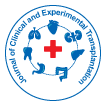Notre groupe organise plus de 3 000 séries de conférences Événements chaque année aux États-Unis, en Europe et en Europe. Asie avec le soutien de 1 000 autres Sociétés scientifiques et publie plus de 700 Open Access Revues qui contiennent plus de 50 000 personnalités éminentes, des scientifiques réputés en tant que membres du comité de rédaction.
Les revues en libre accès gagnent plus de lecteurs et de citations
700 revues et 15 000 000 de lecteurs Chaque revue attire plus de 25 000 lecteurs
Indexé dans
- Google Scholar
- Recherche de référence
- Université Hamdard
- EBSCO AZ
- Publons
- Euro Pub
- Fondation genevoise pour l'enseignement et la recherche médicale
- ICMJE
Liens utiles
Revues en libre accès
Partager cette page
Abstrait
A Review: Using Hypothermic Storage System to Improve Heart Transplant Outcomes
Ava Noah
During organ transport, a novel technology known as the Cardiac Transport System provides stable and optimal hypothermic control. The purpose of this study was to compare the results of using the system with those of using the conventional static cold storage method after a heart transplant. 62 and 186 patients underwent primary heart transplantation at Stanford University from 2018 to June 2021, with follow-up through May. All-cause mortality was the primary end point, and postoperative complications were the secondary end points. Kaplan-Meier survival analyses, optimal variable ratio matching, and the cox proportional hazards regression model were used [1]. The matched patients were older and had received organs with significantly longer total allograft ischemic times prior to matching. After matching, patients required fewer units of blood product for perioperative transfusion than patients, but their postoperative outcomes—hospital length of stay, primary graft dysfunction, inotrope score, use of mechanical circulatory support, cerebral vascular accident, myocardial infarction, respiratory failure, new renal failure necessitating dialysis, postoperative bleeding reoperation, infection, and survival—were comparable [2].
In conclusion, this is one of the very first retrospective comparison studies to examine the outcomes of heart transplantation with preserved and system-transported organs [3]. Even though the total allograft ischemic time was long, the good results may justify implementing a system that accepts organs from faraway locations to broaden the donor pool.
Revues par sujet
- Agriculture et Aquaculture
- Biochimie
- Chimie
- Food & Nutrition
- Génétique et biologie moléculaire
- Géologie et sciences de la Terre
- Immunologie et microbiologie
- Ingénierie
- La science des matériaux
- Le physique
- Science générale
- Sciences cliniques
- Sciences environnementales
- Sciences médicales
- Sciences pharmaceutiques
- Sciences sociales et politiques
- Sciences vétérinaires
- Soins infirmiers et soins de santé
Revues cliniques et médicales
- Allaitement
- Anesthésiologie
- Biologie moléculaire
- Cardiologie
- Chirurgie
- Dentisterie
- Dermatologie
- Diabète et endocrinologie
- Gastro-entérologie
- Immunologie
- La génétique
- Maladies infectieuses
- Médecine
- Microbiologie
- Neurologie
- Oncologie
- Ophtalmologie
- Pédiatrie
- Recherche clinique
- Soins de santé
- Toxicologie

 English
English  Spanish
Spanish  Chinese
Chinese  Russian
Russian  German
German  Japanese
Japanese  Portuguese
Portuguese  Hindi
Hindi